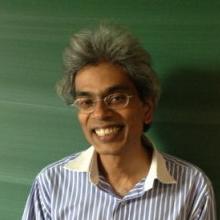PEOPLE
Associates (Former)
Brief Bio
- 1994-1999, Ph.D at the Tata Institute of Fundamental Research, Mumbai, India.
- 1999-2002, Postdoctoral fellow at University of California, Santa Barbara, USA.
- 2002-2005, Post doctoral fellow at the International Centre for Theoretical Physics, Trieste, Italy
- 2005-2007, Reader-F, Harish-Chandra Research Institute, Allahabad, India.
- 2007- present, Assistant Professor, Centre for High Energy Physics, Indian Institute of Science, Bangalore, India.
Research Interests
In the past year my research has been focused on various aspects of the gauge/string duality. The highlights of my research are as follows:
- We have continued our investigations of transport phenomena in a class of non-conformal 1+1 dimensional ?eld theories which admit gravity duals. This study has been extended to the situation when these theories are subject to a chemical potential. We have shown that the ratio of bulk viscosity to entropy density is unchanged in the presence of a chemical potential and is given by the universal number, ¯h/4πkB. Here ¯h is the Planck constant and kB is the Boltzmann constant. We have shown that these systems exhibit a hidden 2+1in variance in the regime of validity of the gravity dual.
- We have derived holographic sum rules which constrain the shear spectral density of a class of conformal ?eld theories in various dimensions at ?nite chemical potential. The modi?cations due to the presence of the chemical potential are shown to arise due to presence of additional scalars in the operator product expansion of the stress tensor of these theories.
- We have shown that classical string propagation in the background of the BTZ black hole is integrable. Integrability is then used to classify all classical solutions interms of the behavior of a certain spectral density in the complex plane. The integrable structure found for the string sigma model in the BTZ black hole is shown to be the same as that of along twisted SL(2,R) spin chain.



 iisc
iisc ac
ac